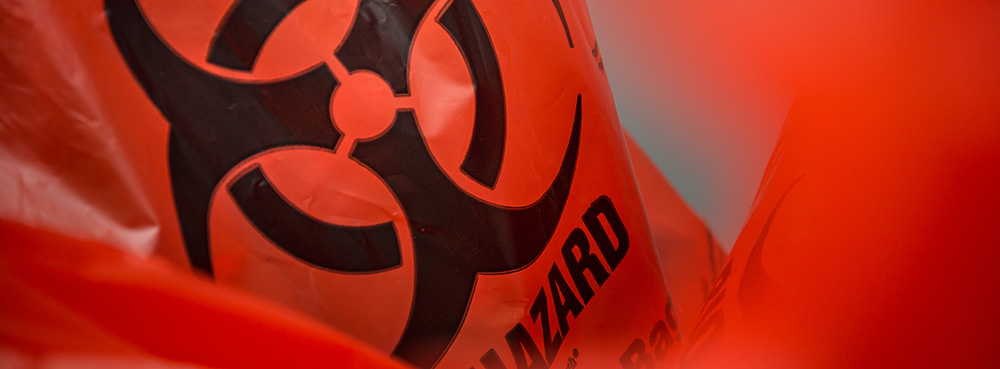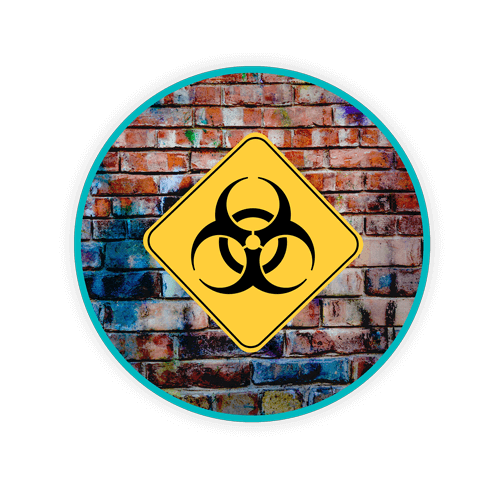Summary of risks with Regulated Medical Waste

Medical waste becomes “regulated medical waste” when it contains enough blood, bodily fluids or other potentially infectious materials (OPIM) that could spread bloodborne pathogens; i.e. it poses a viable risk to humans and the environment. The CDC estimates that over five million workers in the healthcare industry and other related industries are at risk of occupational exposure to bloodborne pathogens through exposure to blood or other potentially infectious materials1, making proper medical waste handling and disposal a critical consideration for infection control.
TOPICS WE WILL COVER:
2 / Risks for Healthcare Workers and Waste Handlers
3 / Liability Risks for Facilities with regards to proper disposal
4 / Environmental Risks and Cost Impact
Defining Regulated Medical Waste
Given that “medical waste” is a term often used as a catchall for any waste that originates from a medical environment, it’s really important to understand that “regulated medical waste” does not include waste such as disposed pharmaceuticals or chemotherapy waste; it is a single healthcare waste stream defined by OSHA’s Bloodborne Pathogen Standard. Names that are often attributed to this waste stream include RMW, infectious waste, biohazardous waste, or biomedical waste.
What is OPIM? (Other Potentially Infectious Materials)
OSHA defines OPIM (Other potentially infectious materials) to mean the following human body fluids: semen, vaginal secretions, cerebrospinal fluid, synovial fluid, pleural fluid, pericardial fluid, peritoneal fluid, amniotic fluid, saliva in dental procedures, any body fluid that is visibly contaminated with blood, and all body fluids in situations where it is difficult or impossible to differentiate between body fluids; (2) Any unfixed tissue or organ (other than intact skin) from a human (living or dead); and (3) HIV-containing cell or tissue cultures, organ cultures, and HIV- or HBV-containing culture medium or other solutions; and blood, organs, or other tissues from experimental animals infected with HIV or HBV2. 
What is Regulated Medical Waste?
OSHA’s Bloodborne Pathogens standard defines regulated medical waste as the following3:
- Liquid or semi-liquid blood or other potentially infectious material
- Contaminated items that would release blood
- OPIM in a liquid or semi-liquid state if compressed;
- Items that are caked with dried blood or OPIM and are capable of releasing these materials during handling
- Contaminated Sharps
- Pathological and Microbiological wastes containing blood or OPIM
It should be noted that the term “contaminated” by OSHA standards refers to anything that has an amount of blood or potentially infectious materials on it, it is not necessarily the same as “regulated”. For example, gauze or PPE that may be slightly contaminated with small absorbed amounts of blood is not considered regulated medical waste.
Are there different guidelines for RMW disposal within clinics vs hospitals?
All healthcare facilities are obliged to comply with the Bloodborne Pathogens Standard irrespective of size or facility type. Employers must evaluate their individual work settings and implement measures to eliminate or minimize employee exposure to Blood or OPIM; protective measures taken must be chronicled in the employers’ exposure control plan.
 Risks for Healthcare Workers and Waste Handlers
Risks for Healthcare Workers and Waste Handlers
The CDC’s estimation of occupational exposure to Bloodborne Pathogens is considered with several variables of infection risk4:
- The pathogen involved
- The type and severity of exposure
- The amount of blood involved in the exposure
- The amount of pathogen in the patient’s blood at the time of exposure
Needlestick Injuries
Needlestick injuries are one of the most commonly discussed risks for healthcare workers as accidental injury can transfer many kinds of viruses and bacteria including Hepatitis C, Syphilis, Varicella Zoster Virus and HIV. Red bags and cardboard boxes (commonly used for the collection of RMW waste in some healthcare settings) pose a unique risk of sharps injuries as they are not puncture-proof and protective of incorrectly discarded needles or contaminated glass.
Pathogen Transmission
The reality is, anyone handling items contaminated with blood or infectious materials is taking on a level of risk, which is why hospitals are increasingly looking at methods to decrease the number of touches of waste and the manual handling of bags or potentially contaminated bins. The problem with red bags and boxes, from a clinical perspective is that waste is kept in patient areas in bins that are rarely if ever cleaned, waste can carry odors and where there is a smell there is a source of pathogens and infection. Given the current focus in US Hospitals of reduction of infections, the last thing that any healthcare facility wants in a clinical environment is any potential source of infection.
Waste Disposal Liability Risks for Facilities
From the manual handling of sharps and infectious waste, to the life-cycle management of waste via an approved medical waste service company, the decisions made by hospitals and clinics with respect to their medical waste management directly affect the risk profile of the organization.
Cradle to Grave Generator Liability
If you’ve conducted any exploration of biohazardous waste management topics, you have undoubtedly come across the term “Cradle to Grave”; this term in its application to medical waste originates from the Resource Conservation and Recovery Act (RCRA) which determines that waste generators are responsible for all hazardous waste they create from the moment it’s generated until the ultimate disposal of that waste. i.e. even when the waste is removed from your clinic or hospital, you continue to be responsible for it. This generator liability makes choosing a waste partner an important decision in risk minimization.
Occupational Risks
Needlestick injuries and other occupational risks associated with the handling of healthcare waste can have a significant cost and insurance impact on a hospital or clinic. The adoption of Safety Engineered Devices in the form of both sharps and sharps containers should be the norm for healthcare facilities to prevent injuries, and OSHA requires that employees annually review their procedures and devices to determine whether an exposure risk exists. If a safer device is commercially available, the employer is required by law to assess the safer device. With infection transmission and pathogen exposure being an increasing concern for healthcare facilities, this review of safer devices goes beyond SED devices or sharps containers, hospitals and clinics should also be examining the safety and cleanliness profile of regulated medical waste containers and exposure risks during waste handling.
Fines and Penalties
Regulated medical waste is governed by OSHA and is thereby accountable for failure to comply with regulations around accredited training for staff handling medical waste, the compliant storage and labeling of waste, and the “cradle to grave” lifecycle of the waste being treated in a manner appropriate to the waste type. Two county hospitals were fined almost $400,000 in two separate lawsuits for the improper handling, transportation and storage of medical waste both at the hospital site and in the final waste destination – the city of San Diego landfill.
Environmental Risks and Cost Impact
Needless to say, there is a direct environmental impact on incorrectly segregated waste because waste that should be incinerated could indirectly end up in landfill if disposed in the incorrect waste stream within a hospital or other healthcare environment. However, going the other way, overcategorized waste (i.e. waste that should go to landfill that ends up being incinerated or processed through higher risk profiled techniques) can have a significant cost impact on a healthcare facilities’ waste management budget. Some considerations for hospitals and clinics include:
1 / Right-fit Bins and Containers
Partner with experts that can deploy right-fit solutions for the waste types and volumes your facility generates. Some service providers try to retro-fit a regulated waste management process without considering a health facilities unique requirements. This can lead to oversized containers being used that are not fit for purpose and an increase in the volume and mass of regulated waste collected.
2 / Training and Auditing
Conduct regular waste audits to vet the correct segregation of wastes and deploy training where needed. For hospitals, the auditing and training process is an integral part of a waste management program that will directly impact costs, compliance risks and correctly attributed medical waste volumes.
3 / Waste Storage, Transport and Treatment Compliance
Government requirements for managing regulated medical waste can vary from State to State; therefore it’s critical that your facility is partnered with a waste provider that is well versed in local regulations and licensed to both transport and treat waste within your State. Lack of compliance in any area of the medical waste life cycle, from disposal and storage to transport and treatment, can lead to violations and fines. Choosing a waste partner that is not going to be managing every aspect of your waste journey (i.e. a broker or someone that sub-hauls either transport or treatment) comes with inherent risks that you as a waste generator need to be aware of.
In Summary
Yes, there are risks involved with regulated medical waste, but they don’t need to be scary or too complex to navigate; like anything in life, it’s all about getting the right partners and the right information to be able to make smart educated decisions. At Daniels, we manage the risks for our customers by being the experts and continually driving our products and processes to higher standards of quality and innovation. A few highlights:
- We own the medical waste disposal process from cradle to grave, our trucks, our treatment and local support
- Our national service infrastructure means that we are disposing of waste within the State that it is generated
- Our sharps and medical waste containers lead the industry in safety and infection control (backed by scientific research and clinical studies)
- We audit, we educate, we examine bin placement and movement, we benchmark against best practice…. We partner for results
If you’re curious as to how you can better manage risks associated with your regulated medical waste management, we would be happy to organize a consultation with one of our experts.
1 Occupational Safety and health administration | OSHA.gov
2 Occupational Safety and health administration | OSHA.gov/bloodborne-pathogens/hazards
3 Occupational Safety and health administration | OSHA.gov/laws-regs
4 cdc.gov/oralhealth/infectioncontrol/faqs/occupational-exposure.html
Let's Talk!
Your time is valuable, and we don’t want to play hard to get. You can either phone us directly on the details listed on our contact page, or feel free to fill out this short form and one of our team members will get back to you as quickly as possible.
